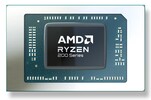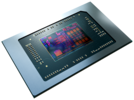Intel Core Ultra 7 265HX vs AMD Ryzen 9 H 270 vs AMD Ryzen 7 PRO 8840HS
Intel Core Ultra 7 265HX
► remove from comparison
The Intel Core Ultra 7 265HX is a mobile high-end CPU for gaming notebooks based on the Arrow Lake architecture. It offers 20 cores consisting of 8 fast performance cores with up to 5.3 GHz and 12 of the 16 smaller efficiency cores with up to 4.6 GHz clock speed. The CPU can access 36 MB L2 cache and 36 MB L3 cache and is specified with a TDP of 55 Watts (160 Watts maximum Turbo).
The SoC integrates a small dedicated NPU called AI Boost with 13 TOPS (Int8) and optionally supports vPro Enterprise. The integrated memory controller supports up to 192 GB DDR5-6400 (dual channel, ECC optional). The integrated GPU (iGPU) is a small Intel Graphics graphics card with four Xe cores running at 300 - 1900 MHz.
Performance - High End
Thanks to the improved IPC of the cores (especially the efficiency cores), the CPU should be just before or at the level of the Raptor Lake Core i7-14700HX (8 + 12 cores, max 5.5 / 3.9 GHz). This makes the CPU ideal for demanding tasks such as high-end gaming and content creation.
Production - TSMC and Foveros
The Arrow Lake-HX chips are based on the desktop Arrow Lake-S chips and are composed of several chiplets. The CPU part is manufactured at TSMC in the modern N3B (3nm) process, the GPU also comes from TSMC in the N5P process. The SoC and I/O tile are manufactured in the TSMC N6 process. The base tile is manufactured by Intel in the 22nm process and carries the individual chiplets thanks to Fovero's 3D packaging.
AMD Ryzen 9 H 270
► remove from comparison
The Ryzen 9 H 270 is a rebadged Ryzen 9 270 (or Ryzen 9 8945HS) for China, making it a fast mobile laptop processor. This is an APU of the Hawk Point family that has eight Zen 4 cores running at 4.0 GHz to 5.2 GHz. This APU was introduced at CES 2025 and all of its cores are SMT-enabled for a total of 16 processing threads.
Architecture and Features
Hawk Point family chips are powered by the Zen 4 architecture, much like Phoenix and Dragon Range family chips were. The 16 TOPS NPU present here isn't powerful enough for systems built around the 9 270 to be Copilot+ certified.
Elsewhere, the chip has 16 MB of L3 cache and support for super-fast DDR5-5600 and LPDDR5x-7500 RAM while also being compatible with USB 4 and thus with Thunderbolt. It comes with 20 PCIe 4 lanes, giving fast NVMe SSD up to 7.8 GB/s of throughput.
Please note that this processor is not overclockable and neither is it user-replaceable. It gets soldered to the motherboard for good instead (FP8 socket interface).
Performance
Its CPU performance is slated to be identical to the old Ryzen 9 8945HS and R9 7940HS.
Your mileage may vary depending on how high the CPU power limits are and how competent the cooling solution of your system is.
Graphics
The Radeon 780M has 12 CUs (768 shaders) purring away at up to 2,800 MHz. The Radeon will let you use up to 4 monitors with resolutions as high as SUHD 4320p and it will also HW-decode and HW-encode the most widely used video codecs (such as AV1, HEVC and AVC) without breaking a sweat. As for gaming, most 2024 games run fine at 1080p with settings set to Low on this graphics adapter.
Your mileage may vary depending on how high the CPU power limits are, how competent the cooling solution of the system is, how fast the RAM of the system is (there is no dedicated VRAM here).
Power consumption
This Ryzen 9 series chip has a long-term power limit (default TDP) of 35 W to 54 W, giving laptop makers a choice between longer battery life and higher performance. Either way, an active cooling solution is a must for a system powered by this chip.
The R9 H 270 is built with TSMC's 4 nm process for a reasonably good, as of early 2025, energy efficiency.
AMD Ryzen 7 PRO 8840HS
► remove from comparison
The Ryzen 7 PRO 8840HS is a powerful processor (APU) of the Hawk Point family. This isn't an entirely new laptop chip; instead, it's a rebadged Ryzen 7 7840U with a slightly higher wattage as well as higher clock speeds on the Ryzen AI NPU. The 8840HS has eight Zen 4 cores running at 3.3 GHz to 5.1 GHz that are SMT-enabled for a total of 16 processing threads, while the great Radeon 780M is responsible for 3D processing and similar duties. Compared to the consumer 8840HS, the PRO variant supports AMD PRO technologies with management features and usually longer availability and support.
Architecture & Features
Hawk Point family chips are powered by the Zen 4 architecture, much like Phoenix and Dragon Range family chips are. That's not to say there is no difference between the three. With Hawk Point, AMD is betting big on generative AI; these processors are set to deliver an up to 40% increase in generative AI performance over 7040 series APUs, making apps like DaVinci Resolve and Adobe Photoshop more useful than ever before.
Unlike Zen 3, Zen 4 features AVX512 support and, thanks to a plethora of other improvements including larger caches/registers/buffers, is slated to bring a double-digit IPC improvement over the former.
Elsewhere, the R7 PRO 8840HS has 16 MB of L3 cache and support for super-fast DDR5-5600 and LPDDR5x-7500 RAM. The chip is compatible with USB 4 and therefore with Thunderbolt. It comes with 20 PCIe 4 lanes, giving NVMe SSDs up to 7.8 GB/s of throughput.
Systems built around this Ryzen 7 series APU are designed to run 64-bit Windows 11, 64-bit Windows 10, or Linux. Please note that this processor is not overclockable and neither is it user-replaceable. It gets soldered down for good instead (FP7, FP7r2, FP8 socket interfaces).
Performance
Since this is a 7840U in disguise that we are dealing with here, it is safe to expect the 8840HS to be about as fast as the Core i7-12650H, as far as multi-thread performance is concerned.
Your mileage may vary depending on how high the CPU power limits are, and how competent the cooling solution of your laptop is.
Graphics
The Radeon 780M has 12 CUs (768 shaders) purring away at up to 2,700 MHz. This is exactly the right iGPU for people looking for a bit more horsepower than what Intel's aging Xe options can provide. The Radeon will let you use up to 4 monitors with resolutions as high as SUHD 4320p and it will also HW-decode and HW-encode the most widely used video codecs (including AV1, HEVC and AVC) without breaking a sweat. In terms of gaming, the thing is good enough for 1080p and medium-to-low settings, as of late 2023.
Your mileage may vary depending on how high the CPU power limits are, how competent the cooling solution of your system is, how fast the RAM of your system is (there is no dedicated VRAM here).
Power consumption
This Ryzen 7 series chip has a long-term power limit (default TDP) of 28 W that laptop makers are free to tune to their liking, with values between 20 W and 30 W greenlighted by AMD. Either way, an active cooling solution is a must for any system powered by this chip.
The 8840HS is built with TSMC's 4 nm process for high, as of late 2023, energy efficiency.
| Model | Intel Core Ultra 7 265HX | AMD Ryzen 9 H 270 | AMD Ryzen 7 PRO 8840HS | ||||||||||||||||||||||||||||||||||||||||||||||||||||||||||||||||||||||||||||||||||||||||||||||||||||||||||||||||||||||||||||||||||||||||
| Codename | Arrow Lake-HX | Hawk Point-HS (Zen 4) | Hawk Point-HS (Zen 4) | ||||||||||||||||||||||||||||||||||||||||||||||||||||||||||||||||||||||||||||||||||||||||||||||||||||||||||||||||||||||||||||||||||||||||
| Series | Intel Arrow Lake | AMD Hawk Point (Zen 4/4c) | AMD Hawk Point (Zen 4/4c) | ||||||||||||||||||||||||||||||||||||||||||||||||||||||||||||||||||||||||||||||||||||||||||||||||||||||||||||||||||||||||||||||||||||||||
| Series: Hawk Point (Zen 4/4c) Hawk Point-HS (Zen 4) |
|
|
| ||||||||||||||||||||||||||||||||||||||||||||||||||||||||||||||||||||||||||||||||||||||||||||||||||||||||||||||||||||||||||||||||||||||||
| Clock | 2300 - 5300 MHz | 4000 - 5200 MHz | 3300 - 5100 MHz | ||||||||||||||||||||||||||||||||||||||||||||||||||||||||||||||||||||||||||||||||||||||||||||||||||||||||||||||||||||||||||||||||||||||||
| L2 Cache | 36 MB | 8 MB | 8 MB | ||||||||||||||||||||||||||||||||||||||||||||||||||||||||||||||||||||||||||||||||||||||||||||||||||||||||||||||||||||||||||||||||||||||||
| L3 Cache | 36 MB | 16 MB | 16 MB | ||||||||||||||||||||||||||||||||||||||||||||||||||||||||||||||||||||||||||||||||||||||||||||||||||||||||||||||||||||||||||||||||||||||||
| Cores / Threads | 20 / 20 8 x 5.3 GHz Intel Lion Cove P-core 12 x 4.6 GHz Intel Skymont E-core | 8 / 16 8 x 5.2 GHz AMD Zen 4 | 8 / 16 8 x 5.1 GHz AMD Zen 4 | ||||||||||||||||||||||||||||||||||||||||||||||||||||||||||||||||||||||||||||||||||||||||||||||||||||||||||||||||||||||||||||||||||||||||
| TDP | 55 Watt | 45 Watt | 28 Watt | ||||||||||||||||||||||||||||||||||||||||||||||||||||||||||||||||||||||||||||||||||||||||||||||||||||||||||||||||||||||||||||||||||||||||
| TDP Turbo PL2 | 160 Watt | ||||||||||||||||||||||||||||||||||||||||||||||||||||||||||||||||||||||||||||||||||||||||||||||||||||||||||||||||||||||||||||||||||||||||||
| Technology | 3 nm | 4 nm | 4 nm | ||||||||||||||||||||||||||||||||||||||||||||||||||||||||||||||||||||||||||||||||||||||||||||||||||||||||||||||||||||||||||||||||||||||||
| iGPU | Intel Graphics 4-Core iGPU (Arc) (300 - 1900 MHz) | AMD Radeon 780M ( - 2800 MHz) | AMD Radeon 780M ( - 2700 MHz) | ||||||||||||||||||||||||||||||||||||||||||||||||||||||||||||||||||||||||||||||||||||||||||||||||||||||||||||||||||||||||||||||||||||||||
| Architecture | x86 | x86 | x86 | ||||||||||||||||||||||||||||||||||||||||||||||||||||||||||||||||||||||||||||||||||||||||||||||||||||||||||||||||||||||||||||||||||||||||
| Announced | |||||||||||||||||||||||||||||||||||||||||||||||||||||||||||||||||||||||||||||||||||||||||||||||||||||||||||||||||||||||||||||||||||||||||||
| Manufacturer | www.intel.com | www.amd.com | www.amd.com | ||||||||||||||||||||||||||||||||||||||||||||||||||||||||||||||||||||||||||||||||||||||||||||||||||||||||||||||||||||||||||||||||||||||||
| L1 Cache | 512 KB | 512 KB | |||||||||||||||||||||||||||||||||||||||||||||||||||||||||||||||||||||||||||||||||||||||||||||||||||||||||||||||||||||||||||||||||||||||||
| Die Size | 178 mm2 | 178 mm2 | |||||||||||||||||||||||||||||||||||||||||||||||||||||||||||||||||||||||||||||||||||||||||||||||||||||||||||||||||||||||||||||||||||||||||
| max. Temp. | 100 °C | 100 °C | |||||||||||||||||||||||||||||||||||||||||||||||||||||||||||||||||||||||||||||||||||||||||||||||||||||||||||||||||||||||||||||||||||||||||
| Socket | FP8 | FP7/FP7r2/FP8 | |||||||||||||||||||||||||||||||||||||||||||||||||||||||||||||||||||||||||||||||||||||||||||||||||||||||||||||||||||||||||||||||||||||||||
| Features | DDR5-5600/LPDDR5x-7500 RAM, PCIe 4, USB 4, Ryzen AI (16 TOPS), MMX, SSE, SSE2, SSE3, SSSE3, SSE4A, SSE4.1, SSE4.2, AVX, AVX2, AVX-512, BMI2, ABM, FMA, ADX, SMEP, SMAP, SMT, CPB, AES-NI, RDRAND, RDSEED, SHA, SME | DDR5-5600/LPDDR5x-7500 RAM, PCIe 4, Ryzen AI, AES, AVX, AVX2, AVX512, FMA3, MMX (+), SHA, SSE, SSE2, SSE3, SSE4.1, SSE4.2, SSE4A, SSSE3 |
Benchmarks
Average Benchmarks Intel Core Ultra 7 265HX → 100% n=2
Average Benchmarks AMD Ryzen 9 H 270 → 77% n=2
Average Benchmarks AMD Ryzen 7 PRO 8840HS → 81% n=2
* Smaller numbers mean a higher performance
1 This benchmark is not used for the average calculation













